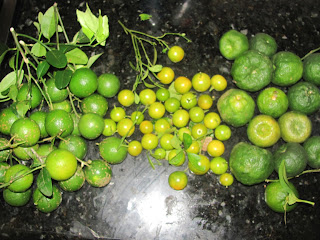It's been 18 months since we made the move to Guam and I am not canning nearly as much as I did in VA. I've made a lot of Mango and Guava jam for Christmas gifts, but I miss hearing the ping of sealing jars on a regular basis. So when I heard about the Food In Jars Mastery Challenge, I knew I had to take part. Basically, each new month is an opportunity to work on a different food preservation technique or skill.
January's topic was MARMALADES. Now, I'm not one of those people who dislike marmalade, but I'm not going to go out of my way to get my hands on it. And I certainly have never taken the time to make it, because unless I can get local, spray-free citrus, I'm not real interested... unlike most Navy families, we have never lived in Florida or California! When one lives on Guam, however, the first thing that pops into your head when you hear 'local citrus' is Calamansi.
I'd never heard of it before I came here. In other parts of the world, it is called Calamondin (I've also seen both words spelled with a 'k'.) It's a small lemony-limey type citrus fruit most often juiced for a drink similar to lemonade. I don't like to drink my calories (I eat more than enough of them as it is!) so I've never tried it, but I know many friend who enjoy it. So, my reasoning went, if people enjoy the taste enough to drink, certainly it should make a good marmalade. An on-line search revealed that calamansi marmalade is, indeed, a 'thing', so I decided that's what I was going to make.
When I asked a group of friends where I could get my hands on some, they all said "Call Sabrina! She's got a ton!" So I did, and she had just enough left to give it a go. (She'd foraged them from a tree on the side of the road. I knew they were organic!) Well, I followed the directions perfectly and I ended up with the most bitter-tasting, disgusting product to ever come out of my kitchen. I am really good at 'saving' jams that don't come out as expected, but there was just nothing I could do with this stuff.
Then I got to talking to my friend Susan, whose in-laws have a farm here on the island. "Are you SURE you were using Calamansi and not local lemon?" she asked. Um, not really! A couple days later she presented me with 3 different kinds of Guam citrus. She was right... my calamansi marmalade wasn't calamansi at all!
On the left are the fruits referred to as 'local lemons'. I have no idea what the rest of the world calls them, if they even grow in the rest of the world. In the middle are the calamansi, which you can see are much smaller (they will turn orange if left on the tree, but the locals here consider them gone-by at that point.) On the right are the local tangerines, very similar to clementines except they have a green skin and a white flesh, and aren't quite as sweet.
I immediately got to work on my second attempt at marmalade, this time using true calamansi. I used this site as my guide. I started with about 4 cups of fruit. I washed them and then cut them in half, taking out the seeds and slicing them (trying to save as much juice as possible.) I figured out too late that it was probably easier to get all the seeds out by cutting along the 'equator' of the fruit instead of from pole to pole.
This gave me 2 cups of fruit, which went into a pan along with 1 1/2 cups of water.
I let that simmer for a good 20 minutes to soften the skins. This is also a great time to remove all of the seeds you missed!
Once cooled, it went into the fridge overnight to help develop the natural pectin. The next day, I added an equal amount of sugar and let it boil until it got to 220 (which didn't take nearly as much time as it did when I used the local lemons, which surprised me). Normally, I use half as much sugar as fruit in my jams, but this is not the time for that. First of all, the sugar is needed for taste since the fruit is so sour. And secondly, with no commercial pectin, the sugar is needed to ensure the marmalade will set up. Then I processed it in a boiling water bath for 10 minutes.
The results were a pleasant surprise. Sweet and tart and not very bitter, it was actually kind of delightful. I am hoping to try it in my tropical bar recipe the next time I need to bring a dessert somewhere. It would also be really good as a glaze over blueberry cheesecake, I'm sure!





Hoping to try, did you use the juice in the recipe?
ReplyDelete